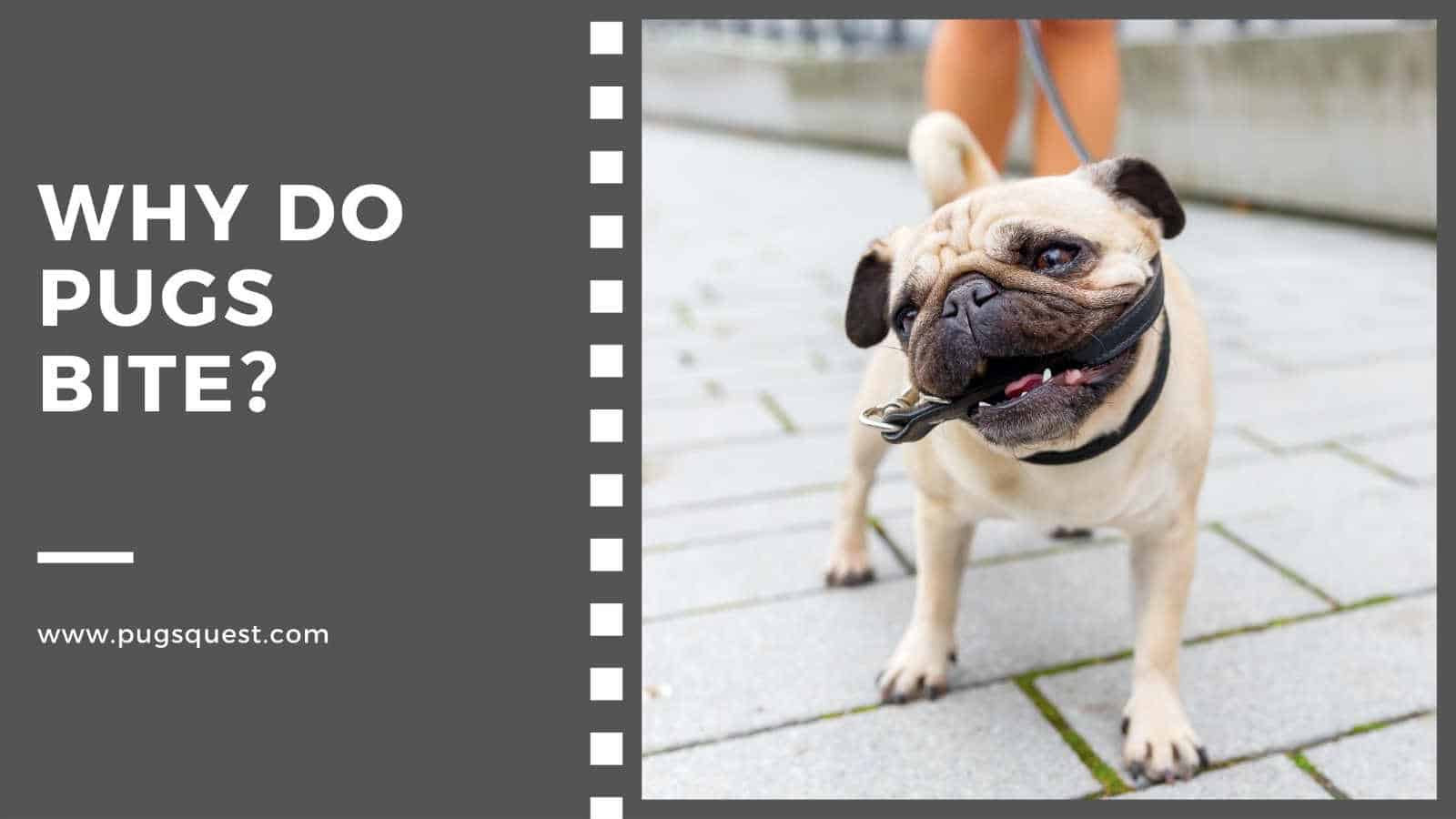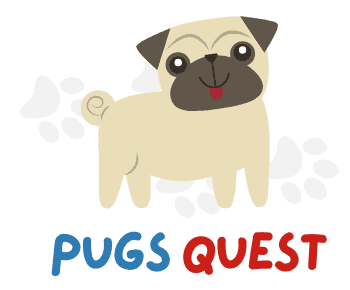
How can we know when enough is enough?
In this article, we’ll be laying down some ground rules for your pup and helping you understand why Pugs bite.
Is your Pug puppy biting?
If yes, then this one’s for you.
Why Do Pugs Bite?
There are many reasons why dogs resort to biting. But when Pugs are puppies, biting and nipping is just part and parcel of growing up. Pups explore their new world with their mouths. And a few nips here and there is just part of the experience.
Here are some of the most common reasons why your Pug puppy might be biting.
1. They are afraid
If your pup is afraid, startled, or stressed for any reason they might react by nipping or biting in defense. When your Pug is still very young, this is not a worrying act of aggression. Nipping is a perfectly normal reflex reaction when your pup is feeling anxious or vulnerable.
2. They are asserting dominance
Sometimes pups bite as a way to show dominance over you. Even though Pug puppies are tiny, they still have a big ego. You’ll need to let them know who’s boss.
3. They are exploring
Pups explore their new surroundings with their mouths and noses. Mouthing behavior is part and parcel of being a pup. They can’t explore things with their hands after all. That’s why pups of all breeds are known for chewing up anything and everything in sight.
4. It’s playtime
Your pup is just having fun. When your Pug is still a puppy, they will not understand that a nip or a bite is a bad thing. It’s all just fun and games to them. That’s why starting behavior training from an early age is essential. That way the nipping phase will be just that. A phase.
5. They are teething
Last but not least, just like human babies, Pug pups go through a teething stage. And, just like human babies, your pup will want to chew on everything in sight.
What they are actually doing is trying to soothe the pain that they are feeling during the teething process. Your puppy’s gums will be very sensitive during this time.
To help them out, offer your pup a teething toy to chew on or some cold ice cubes to soothe those sore gums.
Mouthing, Nipping and Biting in Pugs: What’s The Difference?
Canines use their mouths for a lot of activities and functions. But not all oral behavior constitutes biting. Biting, nipping, and mouthing are all slightly different.
- Biting describes when a dog clamps down hard on an object or person.
- Nipping is not an act of aggression but a play response, or a reaction to a moment of fear or anxiety.
- Mouthing is a natural explorative behavior – especially for puppies during the teething phase.
When Should I Be Worried?
There comes a time when you’ll need to tell your Pug pup that enough is enough. As your pooch gets older, play biting can turn into real biting. And if you don’t teach them the difference you could have a problem in the future. If your Pug continues to bite into maturity, it’s time for some training.
Luckily, a Pug’s bite is not particularly dangerous. Most Pugs aren’t able to bite hard enough to break the skin or cause significant harm. But biting behavior is still not to be encouraged.
However, if your adult Pug starts to bite for no apparent reason, it’s important to visit your vet as this could be an early warning sign that your Pug is suffering from illness or injury of some kind.
How To Stop My Pug From Biting: The Dos and Don’ts
If you feel it’s time to get your Pug pup out of the biting stage, we’ve got some tips and tricks to help you out. With some basic training and clever hacks, you’ll get your pup to quit the habit in no time. So, without further ado, here are our Pug puppy biting dos and don’ts.
1. DO squeal and yelp
This might sound a bit odd, but letting out a squeal or yelp when your pup nips or bites is a bit like speaking puppy language. When puppies play together in the litter this is how they tell their brothers and sisters to back off. So we can do this too. A high-pitched squeal will translate to your pup a clear ‘no’.
2. DO use chew toys
As your pup starts to mature, stop letting their mouth on your hands and introduce a chew toy instead. You don’t want to reinforce that your hands are a play toy. Plus you can incorporate the chew into tons of fun and games around the house and garden.
3. DO train your pup
Now that your pup is growing, it’s time to start some basic behavior and command training. Around this time we want to be teaching our pups to feel relaxed when we place our hands in or around their mouth area – without biting.
And if your pup has been eating everything in sight – I’m talking slippers, cables, furniture, you name it – it’s time to nip that in the bud as well. Encourage your pup to stop biting by diverting their attention with a delicious treat and plenty of praise.
Some pups will develop food aggression. They may become super protective of their dinner and nip or bite when anybody tries to come near. If this keeps happening simply remove their bowl and replace it when they’ve calmed down. Only let your Pug eat when the biting behavior ceases.
If your pup is a persistent biter try placing your thumb under their tongue and finger under the chin and hold for ten seconds. This is a dog trainer’s top trick. It’s completely harmless, but your Pug will get the message.
4. DO assert your dominance
You are in charge. Not your Pug. Pugs can be stubborn and prone to jealousy. But don’t give in to their demanding natures. You’re the boss and that’s got to be super clear. Be assertive and reward good behavior with any kind of positive reinforcement – love, cuddles, and treats are usually best.
5. DO socialize your pup
Socialization is essential for your pup’s development. Puppies learn a lot from interacting with each other in the litter but socializing your Pug shouldn’t stop when they come home. Providing plenty of contact opportunities with other dogs and people is really important.
Expose your pup to a variety of situations – even those that might be stressful the first time around (e.g. walking near cars or playing with children). This way you’ll be able to teach your pup not to bite out of fear. Just remember to always supervise when your puppy is playing with Children.
6. DON’T punish your pup
It might seem like the natural reaction but punishing or scolding your pup for biting and nipping could actually do more harm than good. Your Pug will think that you are dangerous and will most likely continue biting out of fear, as a way of protecting themselves from you.
7. DON’T playback
Lastly don’t playback if your pup is in a particularly nippy mood. If you do then your Pug will think that nipping and biting are totally fun. So resist temptation and give them some cuddles once they have calmed down.
Nip That Pug Biting In The Bud
Pugs puppies nip, mouth, and bite. It’s completely normal. But as your Pug matures, it’s time to nip that behavior in the bud.
Do not let your Pug bite in perpetuity. Eventually, they must learn that this is not okay.
So start training and stop your Pug puppy biting as soon as possible.
And whilst you’re here why not check out this great video where you can pick up some more tips and tricks to help stop your pup from biting.
